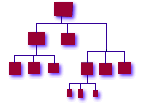


|

|
|
home | sitemap | abstract | introduction | chaos | thinking | checklist | migrating | recovery pushpull | cost | career | workshop | isconf | list_and_community | papers | references |
Time SynchronizationPrerequisites: Directory Servers Without good timestamps on files, backups don't work correctly and state engines such as 'make' get confused. It's important not to delay implementing time synchronization. You will probably use NTP for this. Many types of applications need accurate time too, including scientific, production control, and financial. It's possible for a financial trader to lose hundreds of thousands of dollars if he refers to a workstation clock which is set wrong. A $200 radio clock and NTP can be a wise investment. Shy away from any tool which periodically pops machines into the correct time. This is the solution implemented on several PC based systems. They get their time when they connect to the server and then never update again. It works for these systems because they do not traditionally stay up for long periods of time. However, when designing for the infrastructure, it helps to think that every system will be up 24x7 for months, or even years, between reboots. Even if you put a "time popper" program in crontab, bizarre application behavior can still result if it resets the clock backwards a few seconds every night. Eventually, you will implement NTP [ntp] . It is only a matter of time. NTP has become a standard for time services in the same way that DNS has become a standard for name services. The global NTP stratum hierarchy is rooted at the atomic clocks at the NIST and Woods Hole. You can't get much more authoritative. And NTP drifts clocks by slowing them down or speeding them up -- no "popping". If your network is connected to the Internet, your ISP may provide a good NTP time source. Even if you need to run an isolated set of internal time servers, and sync to the outside world by radio clock or wristwatch, NTP is still the better choice because of the tools and generic knowledge pool available. But you may want to have only one stratum 1 server in this case; see the NTP docs for an explanation. You should also prefer a radio clock over the wristwatch method -- see the trader example above. For large infrastructures spread over many sites, you will want to pick two or three locations for your highest stratum NTP servers. Let these feed regional or local servers and then broadcast to the bottom tier. |
|
||||||||
|
© Copyright 1994-2007 Steve
Traugott,
Joel Huddleston,
Joyce Cao Traugott
In partnership with TerraLuna, LLC and CD International |
||||||||